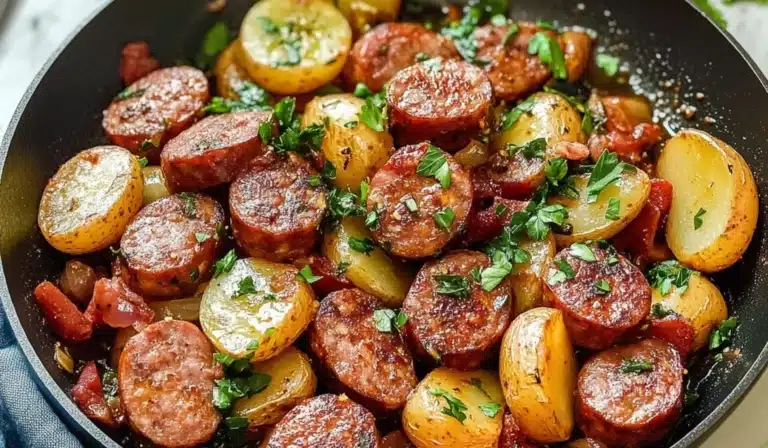Ingredients
Scale
- 1 pound smoked sausage, sliced
- 1 1/2 pounds baby potatoes, halved or quartered
- 2 tablespoons olive oil
- 1 medium onion, diced
- 2 cloves garlic, minced
- 1 teaspoon smoked paprika
- 1 teaspoon Italian seasoning
- 1/2 teaspoon salt
- 1/4 teaspoon black pepper
- 1 bell pepper, sliced
- 1 cup fresh spinach (optional)
- 2 tablespoons fresh parsley, chopped (for garnish)
Instructions
- Parboil Potatoes: Place the halved or quartered potatoes in a large pot and cover them with cold, salted water. Bring the water to a boil, then reduce the heat and simmer for 8-10 minutes, or until the potatoes are fork-tender. This step is crucial for ensuring that the potatoes are cooked through and tender by the time the sausage and other vegetables are ready. Parboiling also helps the potatoes to develop a crispy exterior when they’re cooked in the skillet. Beginner Note: Parboiling means partially cooking the potatoes. They don’t need to be completely cooked through at this stage; they should be slightly softened but still firm.
- Drain and Set Aside: Once the potatoes are parboiled, drain them thoroughly using a colander and set them aside. This will prevent them from continuing to cook and becoming mushy. Beginner Note: Make sure the potatoes are well drained to prevent excess moisture in the skillet.
- Cook Sausage: Heat 1 tablespoon of olive oil in a large skillet (preferably cast iron for even heat distribution and a crispy crust) over medium heat. Add the sliced sausage and cook until browned on both sides, about 4-5 minutes. This step not only cooks the sausage but also renders out some of the fat, adding flavor to the skillet. Remove the cooked sausage from the skillet and set it aside. Beginner Note: Cooking the sausage first prevents it from overcooking later when you add the other ingredients. You want the sausage to be nicely browned and cooked through, but not dried out.
- Sauté Onion and Garlic: In the same skillet (don’t discard the rendered fat – it’s full of flavor!), add the remaining 1 tablespoon of olive oil (if needed – you might have enough fat from the sausage) and sauté the diced onion and minced garlic until fragrant and softened, about 2 minutes. This step builds a flavorful base for the entire dish. Beginner Note: Sautéing means cooking the onion and garlic over medium heat until they are softened and fragrant, but not browned or burned. Garlic can burn easily, so watch it closely.
- Add Bell Pepper: Add the sliced bell pepper to the skillet and cook for another 3-4 minutes, or until it is slightly softened and beginning to caramelize. The bell pepper will add sweetness, color, and a bit of crunch to the dish. Beginner Note: You can adjust the cooking time depending on how crisp-tender you like your bell peppers. If you prefer them softer, cook them a little longer.
- Add Potatoes and Seasonings: Add the parboiled potatoes to the skillet along with the smoked paprika, Italian seasoning, salt, and black pepper. Stir everything together well, ensuring that the potatoes are coated with the seasonings and the rendered fat in the skillet. Cook for 5-7 minutes, stirring occasionally, until the potatoes are golden brown and crispy on all sides. This step creates a beautiful color and texture on the potatoes and infuses them with flavor. Beginner Note: Don’t overcrowd the skillet. If necessary, cook the potatoes in batches to ensure even browning and crispiness. Overcrowding will cause the potatoes to steam instead of crisping up.
- Combine All Ingredients: Return the cooked sausage to the skillet and toss everything together until well combined. Make sure all the ingredients are evenly distributed in the skillet and heated through. Beginner Note: Combining all the ingredients at this stage allows the flavors to meld together beautifully.
- Add Spinach (Optional): If using spinach, stir it into the skillet during the last 2 minutes of cooking. The residual heat from the other ingredients will be enough to wilt the spinach. Beginner Note: Spinach wilts very quickly, so you don’t need to cook it for long. Adding it at the end preserves its vibrant green color and prevents it from becoming mushy.
- Garnish and Serve: Garnish the Sausage and Potatoes Skillet with fresh chopped parsley just before serving. This adds a touch of freshness and visual appeal to the dish. Serve hot and enjoy! Beginner Note: Garnishing adds a final touch of flavor and visual appeal to the dish.
Notes
- Use any type of sausage you prefer.
- Don’t overcrowd the skillet.
- Adjust seasonings to taste.
- Prep Time: 10 minutes
- Cook Time: 25 minutes
- Category: Main Course, Dinner
- Method: Sautéing
- Cuisine: American
